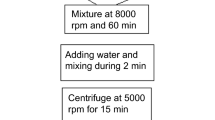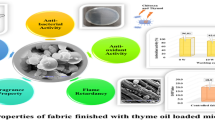Abstract
The aim of this study was to prepare mosquito repellent textiles. To compare bio-based and synthetic mosquito repellent agents, limonene and permethrin were encapsulated with ethyl cellulose shell. Coacervation was employed, which is a simple and reproducible method for the encapsulation with high production efficiency. Morphological assessment showed that the capsules had smooth surfaces and their shape was spherical. The homogenous size distribution of the capsules was supported by laser diffraction analysis. The capsules showed narrow size distribution and the mean particle size of the optimum formulations for limonene and permethrin was 1 and 1.3 μm, respectively. The size of the produced capsules was considered suitable for textile applications. The FTIR spectra revealed the similarity of the chemical structure of capsules with shell material. Cotton fabrics were treated separately with limonene and permethrin capsules by padding method. The presence of capsules on the fabrics was determined after 20 washing cycles. Insecticide activity was evaluated against common house mosquitoes (Culex pipiens), with respect to cone bioassay of World Health Organization (WHO). Mosquitoes were tended to stay away from treated fabrics, and mortality rates of mosquitos were noted as 41% and 54% for limonene and permethrin, respectively. Although efficacy of fabrics decreased with increasing washing, the fabrics still showed repellency after 20 washing cycles. This study showed that the developed product might be used as an alternative to the other products in the market for avoiding mosquito-borne diseases.










Similar content being viewed by others
References
Shahid M, Mohammad F (2013) Perspectives for natural product based agents derived from industrial plants in textile applications—a review. J Clean Prod 57:2–18
Becker N, Petric D, Zgomba M, Boase C, Madon M, Dahl C, Kaiser A (2010) Mosquitoes and their control. Springer, Heidelberg
Benelli G, Mehlhorn H (2018) Mosquitoe-borne diseases. Springer, Dusseldorf
Agnihotri A, Wazed Ali S, Das A, Alagirusamy R (2019) 11 - Insectrepellent textiles using green and sustainable approaches. In: Islam S, Butola BS (eds) The impact and prospects of green chemistry for textile technology, The Textile institute book series. Woodhead Publishing, pp 307–325. https://doi.org/10.1016/B978-0-08-102491-1.00011-3
Chatha SAS, Asgher M, Asgher R, Hussain AI, Iqbal Y, Hussain SM, Bilal M, Saleem F, Iqbal HMN (2019) Environmentally responsive and anti-bugs textile finishes—recent trends, challenges, and future perspectives. Sci Total Environ 690:667–682
Hebeish A, Fouda MG, Hamdy IA, El-Sawy SM, Abdel-Mohdy FA (2008) Preparation of durable insect repellent cotton fabric: limonene as insecticide. Carbohyd Polym 74:268–273
Rodrigues SN, Martins IM, Fernandes IP, Gomes PB, Mata VG, Barreiro MF, Rodrigues AE (2009) Scentfashion®: microencapsulated perfumes for textile application. Chem Eng J149:463–472
Erkan G, Sarıışık M (2015) Antifungal microcapsules of ethyl cellulose by solvent evaporation and their application to cotton fabric. Fibres Tex East Eur 6:125–130
Badulescu R, Vivod V, Jausovec D, Voncina B (2008) Grafting of ethylcellulose microcapsules onto cotton fibers. Carbohyd Polym 71:85–91
World Health Organization (2009) The WHO recommended classification of pesticides by hazard and guidelines to classification 2009. WissenchaftlicheVerlagsgesellschaftmbH, Stuttgart
Anjali CH, Sudheer Khan S, Margulis-Goshen K, Magdassi S, Mukherjee A, Chandrasekaran N (2010) Formulation of water-dispersible nanopermethrin for larvicidal applications. Ecotoxicol Environ Sa 73:1932–1936
Li W, Lu B, Sheng A, Yang F, Wang Z (2010) Spectroscopic and theoretical study on inclusion complexation of beta-cyclodextrin with permethrin. J Mol Struct 981:194–203
Maia MF, Moore SJ (2011) Plant-based insect repellents: a review of their efficacy, development and testing. Malar J 10:1–14
Hirech K, Payan S, Carnelle G, Brujes L, Legrand J (2003) Microencapsulation of an insecticide by interfacial polymerization. Powder Technol 130:324–330
Chang CP, Dobashi T (2003) Preparation of alginate complex capsules containing eucalyptus essential oil and its controlled release. Colloids Surf B 32:257–262
Wen-Chuan H, Chih-Pong C, Ying-Lin G (2006) Controlled release properties of chitosan encapsulated volatile citronella oil microcapsules by thermal treatments. Colloids Surf B 53:209–214
N’Guessan R, Knols BGJ, Pennetier C, Rowlanda M (2008) DEET microencapsulation: a slow-release formulation enhancing the residual efficacy of bed nets against malaria vectors. Trans R Soc Trop Med Hyg 102:259–262
Abdel-Mohdy FA, Fouda MMG, Rehan MF, Aly AS (2008) Repellency of controlled-release treated cotton fabrics based on cypermethrin and prallethrin. Carbohyd Polym 73:92–97
MiróSpecos MM, García JJ, Tornesello J, Marino P, Della Vecchia M, Tesoriero MD, Hermida LG (2010) Microencapsulated citronella oil for mosquito repellent finishing of cotton textiles. Trans R Soc Trop Med Hyg 104:653–658
MiróSpecos MM, García J, Gutierrez AC, Hermida LG (2017) Application of microencapsulated biopesticides to improve repellent finishing of cotton fabrics. J Text I 108:1454–1460
İnceboz T, Erkan G, Türkoğlu GC, Sarıışık AM, Bakırcı S, Üner S, Üner A (2015) In-vivo and in-vitro tick repellent properties of cotton fabric. Text Res J 85:2071–2082
Sittipummongkol K, Chuysinuan P, Techasakul S, Pisitsak P, Pechyen C (2019) Core shell microcapsules of neem seed oil extract containing azadirachtin and biodegradable polymers and their release characteristics. Polym Bull 76:3803–3817
Sharma R, Goel A (2018) Development of insect repellent finish by a simple coacervation microencapsulation technique. Internat J Cloth Sci Tech 30:152–158
Cheng SY, Yuen CWM, Kan CW, Cheuk KKL (2008) Development of cosmetic textiles using microencapsulation technology. RJTA 12:41–51
Peniche C, Arguelles-Monal W, Peniche H, Acosta N (2003) Chitosan: an attractive biocompatible polymer for microencapsulation. Macromol Biosci 3:511–520
Ghosh SK (2006) Functional coatings and microencapsulation: a general perspective. In: Ghosh SK (ed) Functional coatings: by polymer microencapsulation. Wiley-VCH Verlag GmbH & Co. KGaA, Weinheim. https://doi.org/10.1002/3527608478.ch1
Türkoğlu GC (2013) Production and characterization of various capsules which are gained functional properties to textile materials. MSc Thesis, DokuzEylul University, The Graduate School of Natural and Applied Sciences 2013.
Türkoğlu GC, Sarıışık AM, Erkan G, Deveci Ö, Yıkılmaz MS, Kontart O, Öztuna S (2013) Durable insect repellent behaviour of cotton fabric by permethrin capsules. In: 1st International Conference On Natural Fibers, Portugal
Türkoğlu GC, Sarıışık AM, Erkan G, Deveci Ö, Yıkılmaz MS, Kontart O, Öztuna S (2013) Microencapsulated limonene loaded textile and its insect repellent behavior. In: 14th National & 1st International recent developments, textile technology and chemistry symposium, Turkey
World Health Organization (2005) Guidelines for laboratory and field testing of long-lasting insecticidal mosquito nets WHO/CDS/WHOPES/GCDPP/ 2005.11
Abbott WS (1925) A method of computing of the effectiveness of an insecticide. J Econ Entomol 8:265–267
Anoopkumar AN, Puthur S, Rebello S, Aneesh EM (2017) Screening of a few traditionally used medicinal plants for their larvicidal efficacy against aedesaegyptilinn (diptera: culicidae), a dengue fever vector. SOJ Microbiol Infect Dis 5:1–5
Sharma S, Srivastava AK (2005) Free radical copolymerization of limonene with butyl methacrylate: synthesis and characterizaton. Indian J Chem Tech 12:62–67
Minkwan K, Seung HS, Han DG (2014) Nonvolatile insect repelling agent prepared by grafting of permethrin on polybutadiene. Macromol Res 22:1348–1351
Shahba AF, Halawa O, Ragaei M, Hashem M (2011) Development of longer-lasting insect repellence cellulosic based curtain fabrics. Mater Sci Appl 2:200–208
Acknowledgements
This study (00783.STZ.2011-1) was funded by Ministry of Science, Industry and Technology, Republic of Turkey. We also would like to thank Organik Kimya for partial financial support and acknowledge engineer Selda ÖZTUNA for utilizing the facility of the laboratories. We would also like to thank and commemorate Prof. Dr. Önder DEVECİ for his support and suggestions in mosquito bioassays. Preliminary studies about limonene and permethrin capsules were presented on 1st International Recent Developments, Textile Technology and Chemistry Symposium, Turkey and 1st International Conference on Natural Fibers, Portugal.
Author information
Authors and Affiliations
Corresponding author
Rights and permissions
About this article
Cite this article
Türkoğlu, G.C., Sarıışık, A.M., Erkan, G. et al. Micro- and nano-encapsulation of limonene and permethrin for mosquito repellent finishing of cotton textiles. Iran Polym J 29, 321–329 (2020). https://doi.org/10.1007/s13726-020-00799-4
Received:
Accepted:
Published:
Issue Date:
DOI: https://doi.org/10.1007/s13726-020-00799-4




